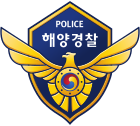This article has multiple issues. Please help improve it or discuss these issues on the talk page. (Learn how and when to remove these messages)
|
| Korean Coast Guard 해양경찰청 Haeyang-gyeongchal-cheong | |
|---|---|
 KCG emblem | |
 | |
 Flag  Ensign | |
| Abbreviation | KCG |
| Agency overview | |
| Formed | July 2017 – present (as 해양경찰청), December 1953 – November 2014 (as 해양경찰청) November 2014 – July 2017 (as 국민안전처 해양경비안전본부) |
| Employees | 10,095 personnel[1] |
| Jurisdictional structure | |
| National agency | South Korea |
| Operations jurisdiction | South Korea |
| Constituting instrument |
|
| Operational structure | |
| Headquarters | Incheon, South Korea |
| Elected officers responsible |
|
| Parent agency | Ministry of Maritime Affairs and Fisheries (2017–present) Ministry of Public Safety and Security (2014–2017) Ministry of Maritime Affairs and Fisheries (1996–2014) Korean National Police Agency (1953–1996)[4] |
| Website | |
| https://www.kcg.go.kr/ | |

The Korea Coast Guard (KCG; Korean: 해양경찰청; Hanja: 海洋警察廳, Revised Romanization: Haeyang-gyeongchal-cheong, literally Maritime Police Agency) is a South Korean law enforcement sub-agency responsible for maritime safety and control off the coast. The KCG is an independent and external branch of Ministry of Maritime Affairs and Fisheries.
The KCG has its headquarters in Incheon, has hundreds of smaller operating stations along the coastline of the Korean Peninsula. It operates 4 classes of heavy vessels (over 1,000 tons), 3 classes of medium vessels (over 250 tons), and 3 classes of light vessels (speedboats over 30 tons). The KCG also uses several types of 'special purpose watercraft', such as firefighting vessels, barges, high-speed scout boats, light patrols, and amphibious hovercraft. The KCG aviation unit fields 6 fixed-wing aircraft and 16 rotary-wing aircraft. The Coast Guard also had its own asymmetric warfare unit named the 'Korean Coast Guard Special Operation Unit'.
- ^ "Korean Coast Guard 2012 White Paper". Archived from the original on 2013-11-05. Retrieved 2013-03-19.
- ^ Coast Guard Act (Act 16515). 2019.
- ^ Kang, Seung-woo (20 June 2018). "New badges in town". The Korea Times.
- ^ "South Korean lawmakers approve plans to disband coast guard in wake of April's ferry disaster". FOX News. Associated Press (AP). 2015-03-24.